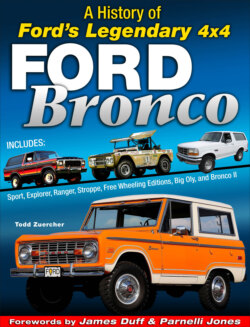Читать книгу Ford Bronco: A History of Ford's Legendary 4x4 - Todd Zuercher - Страница 28
На сайте Литреса книга снята с продажи.
Interior
ОглавлениеBy today’s standards, the Bronco’s interior was stark, but in 1966, Ford proudly bragged about its standard features, including a vinyl rubber floor mat, front seat belts, lockable glove compartment, dual vacuum windshield wipers, ashtray, and the aforementioned column-mounted transmission shifter and single transfer case shifter. The instrument cluster, mounted in the dash to the left of the steering column, housed a speedometer, fuel gauge, temperature gauge, and ammeter. A heater and defroster were optional. A full-width bench seat in front was the standard seat with a metal bulkhead behind it.
The interior of this survivor 1966 roadster shows off the 1966- only silver upholstery on the front and rear seats and the black 1966-only armrests on the rear seat. (Photo Courtesy Tim Hulick)
This roadster is equipped with a set of the mirrors commonly referred to as “roadster mirrors,” so called because they were standard on roadsters. They were seen in 1966 on wagons, sport utilities, and roadsters alike. (Photo Courtesy Freeze Frame Image LLC, Al Rogers)
The standard spare-tire mount for Broncos equipped with a bulkhead behind the front seat was the mount shown on this roadster. An optional mount put the spare tire on the inside of the tailgate, which made it hard to raise and lower due to the added weight. (Photo Courtesy Freeze Frame Image LLC, Al Rogers)
This roadster is equipped with a heater and defroster, a $60.55 option for 1966. The 1966-only knobs were pulled from the Ford truck parts bin. The ashtray was placed near the driver in 1966–1967 and moved closer to the passenger in 1968. The screw-on cover at the right covers the radio speaker; it is found only in roadsters because many of them did not have tops. (Photo Courtesy Freeze Frame Image LLC, Al Rogers)
Rocker trim was introduced in 1966 along with the red and white rocker stripes that were available for that year only. Obviously, you could only have one or the other. (Photo Courtesy Tim Hulick)
THE PONY UPHOLSTERY MYSTERY
The top-of-the-line upholstery available in 1965–1966 Mustangs became known as the Pony upholstery, consisting of sections of horizontal and vertical stitching bisected by a horizontal panel embossed with pony images running toward a small, rectangular badge in the center. Offered in both single and two-tone color combinations, the patterns were definitely a step up from the standard Mustang upholstery.
As the Bronco market heated up, collectors found that a number of the 1966 trucks (6 of 10) have original Pony upholstery on the front and rear seats, even though no official documentation exists to indicate it was ever an option. Because the 1966 Bronco’s front bucket seats are Mustang seats, retrofitting Pony upholstery to them is a fairly straightforward proposition. However, the Bronco’s model-specific rear seat is a bit more challenging to upholster in the Pony pattern.
Because no documentation exists that it was ever a factory option, but several original owners have sworn their trucks came that way from the factory, some historians believe it may have been a dealer-installed option or an aftermarket item available from dealers. Bronco historian Tim Hulick has noted that the body code on the data plate on these trucks is a “9,” which corresponds to the “parchment rosette” code from later years. Hulick also notes that the inset portion of the upholstery that includes the embossed horses is a color that appears to be exclusive to the Broncos.
The Pony upholstery mystery continues to provoke debate and discussion among owners and historians alike.
This 1966 Bronco rear seat is upholstered with the Pony upholstery; the subject of many spirited discussions among Bronco aficionados. Factory or not? The jury is still out. (Photo Courtesy Tim Hulick)
This is a close-up view of the horses in the Pony panel on the front seat. Experts on the 1966 Bronco note that the colors in the upholstery found in the late 1966 examples are Bronco-unique colors not found on any Mustang upholstery. (Photo Courtesy Tim Hulick)
Because 1966 Bronco seats were early Mustang seats, the Pony upholstery fit well on these buckets. The number of trucks upholstered with this pattern is unknown, but a handful of trucks, including those from original owners, have the unique pattern on their seats. (Photo Courtesy Tim Hulick)
Optional was a single (driver’s) or double front bucket seats with a bulkhead behind them. With the buckets, a rear bench was also optional. If the rear bucket was selected, the bulkhead was deleted so access to the rear seat was possible. For 1966, the seats were upholstered in a silver-gray vinyl fabric. The rear seat’s armrests were black in color.
For customers wanting more flash, 1966 Broncos could be ordered with the Custom Equipment package. It included front and rear chrome bumpers, bright-metal taillight bezels, hubcaps (on the 15-inch wheels), armrests on the models with doors, a cigarette lighter, bright-metal horn ring, and sun visors on both sides of the windshield frame. These items could also be ordered individually from the factory.
